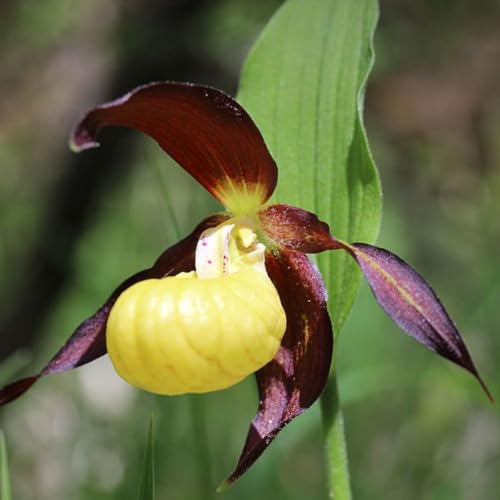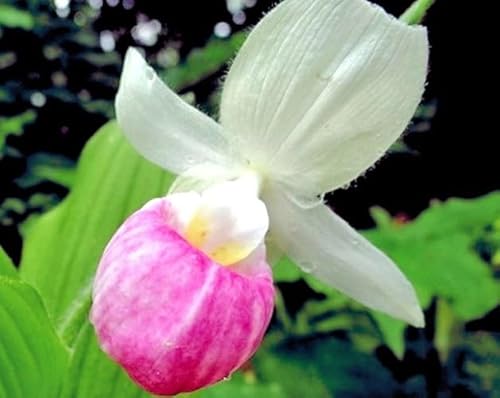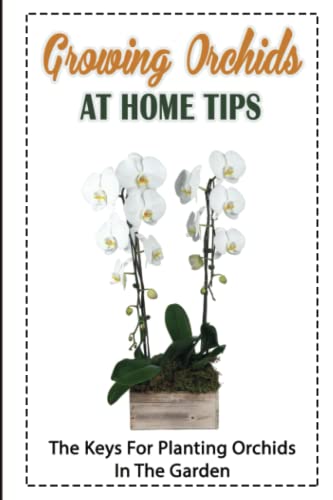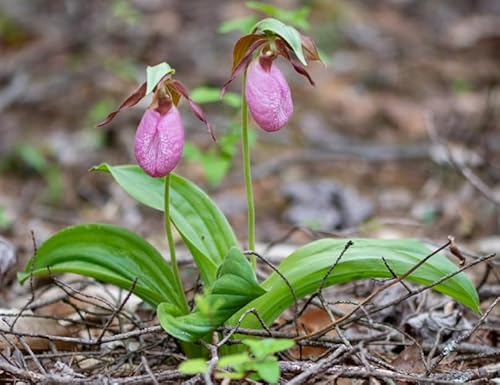About a year ago Southernbelle graciously gifted me a division of Cattleya Dinard ‘Blue Heaven’ AM/AOS. I bloomed it for the first time this past week and this is a picture in 5000K lighting to get the truest color rendering:

The final Dinard genetic mix should be (warscewiczii 25%, warneri 25%, trianae 12.5%, tenebrosa 12.5%, dowiana 12.5%, and schilleriana 12.5%). The AOS AM award for ‘Blue Heaven’ described “flowers pale lavender-blue with darker lavender veins on petals centrally; lip pleasingly ruffled indigo purple with yellow throat veined lighter purple”.
I should just sit back and say, “Beautiful flower”, and enjoy it, but I can’t help being interested in the complex, decades-long, throwing of the genetic dice that creates these heritage plants. When I look at the breeding and award history of Cattleya Dinard, I see some mysteries.
The AOS award record seems to indicate that Dinard is a relatively recent hybrid with the first AOS award in 1999 when Yvonne Kinn showed ‘Kinn’ in Dallas and received an AM. Two years later ‘Blue Heaven’ was shown in Illinois by Hausermanns, receiving an AM. This is the cultivar that seems to have been mericloned and is usually for sale. No other cultivar of Dinard was awarded until 2016 when ‘Veronica’ was shown at the Pacific Northwest Judging Center by Claudia Uribe and received an FCC.
In 2021 Waldor Orchids received a JC in Massachusetts for ‘Blue Waves’, which was acknowledged to be a sport of ‘Blue Heaven’, meaning it arose during a mericloning of ‘Blue Heaven’. It was “commended for presentation of partial sepal peloria”. It had four flowers on an inflorescence, as did ‘Kinn’ and ‘Veronica’, while the awarded ‘Blue Heaven’ had three flowers. In contrast, ‘Blue Heaven’ had modestly larger flowers than ‘Kinn’ and ‘Veronica’.
However, Dinard is not a new hybrid, being registered in 1930 by Charlesworth in England. It was (Saint Gothard x Dinah) and although each of these parents was used over 100 times, they were never AOS awarded, there are no existing pictures of them, and they may have disappeared.
What happened to Dinard from 1930 to 1999? Without access to the RHS database, we don’t know about awards to Dinard in Europe. However, the breeding record for Dinard gives some interesting information. Overall, Dinard has only been used as a parent 40 times, only one Dinard offspring was AOS awarded (don’t know about RHS), and only a few offspring were used further in breeding. Dinard is not one of the great old breeding parents!
Dinard was used only 21 times as a parent from 1942 to 1962 and 12 of those were by Charlesworth. Importantly. I think the breeding record suggests that Dinard was used mostly to breed lavender hybrids until about 1990.
The most suggestive Dinard cross is Elizabeth Off, registered by Off & Sons (originators of what is now Waldor Orchids) in 1947 as (Dinard x Fred Sander). Waldor’s website section on its history tells us that “his (George Off) most famous cross Cattleya Elizabeth Off…” so we must assume that George Off had Dinard as a parent probably before 1940. Elizabeth Off had several highly awarded cultivars, most importantly the FCC to ‘Sparkling Burgundy’. The cultivar name tells us the important fact that Elizabeth Off has a strong lavender flower. This lavender theme was repeated with most of the Dinard offspring who were used as parents, with Dinard paired with great lavender hybrids such as ‘Norman’s Bay’ or ‘Bonanza (Bracey)’.
I don’t see evidence in the breeding record before the 1990s of attempts to create “lavender/blue”/”indigo/purple” hybrids, only lavenders.

The final Dinard genetic mix should be (warscewiczii 25%, warneri 25%, trianae 12.5%, tenebrosa 12.5%, dowiana 12.5%, and schilleriana 12.5%). The AOS AM award for ‘Blue Heaven’ described “flowers pale lavender-blue with darker lavender veins on petals centrally; lip pleasingly ruffled indigo purple with yellow throat veined lighter purple”.
I should just sit back and say, “Beautiful flower”, and enjoy it, but I can’t help being interested in the complex, decades-long, throwing of the genetic dice that creates these heritage plants. When I look at the breeding and award history of Cattleya Dinard, I see some mysteries.
The AOS award record seems to indicate that Dinard is a relatively recent hybrid with the first AOS award in 1999 when Yvonne Kinn showed ‘Kinn’ in Dallas and received an AM. Two years later ‘Blue Heaven’ was shown in Illinois by Hausermanns, receiving an AM. This is the cultivar that seems to have been mericloned and is usually for sale. No other cultivar of Dinard was awarded until 2016 when ‘Veronica’ was shown at the Pacific Northwest Judging Center by Claudia Uribe and received an FCC.
In 2021 Waldor Orchids received a JC in Massachusetts for ‘Blue Waves’, which was acknowledged to be a sport of ‘Blue Heaven’, meaning it arose during a mericloning of ‘Blue Heaven’. It was “commended for presentation of partial sepal peloria”. It had four flowers on an inflorescence, as did ‘Kinn’ and ‘Veronica’, while the awarded ‘Blue Heaven’ had three flowers. In contrast, ‘Blue Heaven’ had modestly larger flowers than ‘Kinn’ and ‘Veronica’.
However, Dinard is not a new hybrid, being registered in 1930 by Charlesworth in England. It was (Saint Gothard x Dinah) and although each of these parents was used over 100 times, they were never AOS awarded, there are no existing pictures of them, and they may have disappeared.
What happened to Dinard from 1930 to 1999? Without access to the RHS database, we don’t know about awards to Dinard in Europe. However, the breeding record for Dinard gives some interesting information. Overall, Dinard has only been used as a parent 40 times, only one Dinard offspring was AOS awarded (don’t know about RHS), and only a few offspring were used further in breeding. Dinard is not one of the great old breeding parents!
Dinard was used only 21 times as a parent from 1942 to 1962 and 12 of those were by Charlesworth. Importantly. I think the breeding record suggests that Dinard was used mostly to breed lavender hybrids until about 1990.
The most suggestive Dinard cross is Elizabeth Off, registered by Off & Sons (originators of what is now Waldor Orchids) in 1947 as (Dinard x Fred Sander). Waldor’s website section on its history tells us that “his (George Off) most famous cross Cattleya Elizabeth Off…” so we must assume that George Off had Dinard as a parent probably before 1940. Elizabeth Off had several highly awarded cultivars, most importantly the FCC to ‘Sparkling Burgundy’. The cultivar name tells us the important fact that Elizabeth Off has a strong lavender flower. This lavender theme was repeated with most of the Dinard offspring who were used as parents, with Dinard paired with great lavender hybrids such as ‘Norman’s Bay’ or ‘Bonanza (Bracey)’.
I don’t see evidence in the breeding record before the 1990s of attempts to create “lavender/blue”/”indigo/purple” hybrids, only lavenders.
Last edited:












































